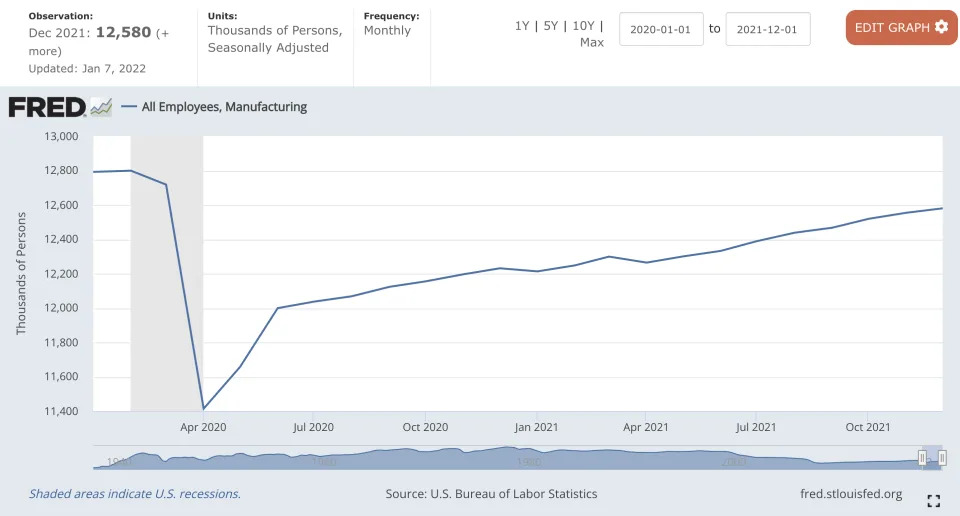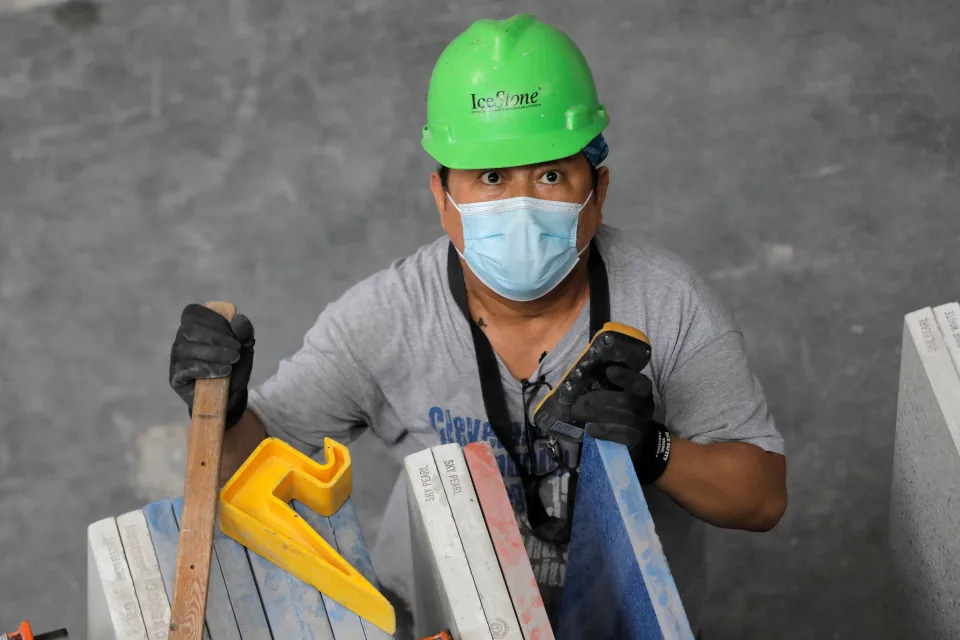Dani Romero
Sat, January 8, 2022
Jobs growth in manufacturing slowed again in December, adding 26,000 new hires after a consensus estimate of 35,000, despite the overall pandemic-era unemployment rate being at 3.9%.
Since the pandemic began, manufacturing companies have brought back nearly 1.2 million jobs out of the 1.4 million jobs lost. In other words, according to the Bureau of Labor Statistics, the industry employs 219,000 fewer people today than it did in February 2020.

Manufacturing jobs in the U.S. have not yet caught up after the pandemic-induced recession. (Source: FRED)
Exacerbating the problem going forward, the industry is evolving rapidly and skilled workers are increasingly scarce.
"Manufacturing has an identity crisis," Paul Wellener, Vice Chairman, US Industrial Products & Construction Leader at Deloitte LLP, told Yahoo Finance (video above). "It's not your father or mother's dirty, dark and dangerous manufacturing anymore. It's really a high tech world out there with no jobs getting less technical."
Consequently, Wellener explained, the manufacturing industry "really does have some challenges as it relates to employment and workers. The jobs are there, but the question is: Where are the people?"

A worker arranges slabs in the factory at IceStone, a manufacturer of recycled glass countertops and surfaces, in New York City, New York, U.S., June 3, 2021. REUTERS/Andrew Kelly
Sat, January 8, 2022
Jobs growth in manufacturing slowed again in December, adding 26,000 new hires after a consensus estimate of 35,000, despite the overall pandemic-era unemployment rate being at 3.9%.
Since the pandemic began, manufacturing companies have brought back nearly 1.2 million jobs out of the 1.4 million jobs lost. In other words, according to the Bureau of Labor Statistics, the industry employs 219,000 fewer people today than it did in February 2020.
Manufacturing jobs in the U.S. have not yet caught up after the pandemic-induced recession. (Source: FRED)
Exacerbating the problem going forward, the industry is evolving rapidly and skilled workers are increasingly scarce.
"Manufacturing has an identity crisis," Paul Wellener, Vice Chairman, US Industrial Products & Construction Leader at Deloitte LLP, told Yahoo Finance (video above). "It's not your father or mother's dirty, dark and dangerous manufacturing anymore. It's really a high tech world out there with no jobs getting less technical."
Consequently, Wellener explained, the manufacturing industry "really does have some challenges as it relates to employment and workers. The jobs are there, but the question is: Where are the people?"
A worker arranges slabs in the factory at IceStone, a manufacturer of recycled glass countertops and surfaces, in New York City, New York, U.S., June 3, 2021. REUTERS/Andrew Kelly
'An opportunity for manufacturers'
Overall, with a record 4.5 million Americans voluntarily leaving their jobs in November and vacancies totaling to 10.562 million in the U.S., suggesting a lingering struggle for employers across industries to retain talent and find new workers.
At the same time, a skyrocketing demand for goods in 2021 caused ongoing supply chain disruptions and put even more pressure on manufacturers to find labor.
"The challenge for manufacturers I believe is to really make manufacturing attractive to the next generation to diverse populations that may not know about manufacturing as an opportunity," Wellener said adding that the situation is actually "an opportunity for manufacturers to continue to sell their business to the employee population out there."
A worker pours hot metal at the Kirsh Foundry in Beaver Dam, Wisconsin, U.S., April 12, 2018. Picture taken April 12, 2018.
REUTERS/Timothy Aeppel
A recent survey by Deloitte found that 38% of executives reported that attracting new workers is their top priority for the production workforce in 2022, followed by retention (31%) and re-skilling (13%).
"Number one, for manufacturers, they need to put their arms around their employees and hug them and tell them how great they are and help them get the skills that are needed for the next set of jobs here into the late 2020s and early 2030s," Wellener said.
A previous report last year by Deloitte found as many as 2.1 million manufacturing jobs will be unfilled through 2030, warning that the worker shortage would hurt revenue, production and could ultimately cost the US economy up to $1 trillion by 2030.
"We've gotta think about is how we prepare the workers that aren't in manufacturing, whether it's through apprentice programs or other kinds of programs," Wellener said. "How do we prepare them for this technologically determined future?"

Alan Ramadan, a refugee from Syria who came to Germany in 2012, attends a job training program as an industrial mechanic at a manufacturing plant of U.S. company Johnson Controls International on April 30, 2019 in Hanover, Germany.
A recent survey by Deloitte found that 38% of executives reported that attracting new workers is their top priority for the production workforce in 2022, followed by retention (31%) and re-skilling (13%).
"Number one, for manufacturers, they need to put their arms around their employees and hug them and tell them how great they are and help them get the skills that are needed for the next set of jobs here into the late 2020s and early 2030s," Wellener said.
A previous report last year by Deloitte found as many as 2.1 million manufacturing jobs will be unfilled through 2030, warning that the worker shortage would hurt revenue, production and could ultimately cost the US economy up to $1 trillion by 2030.
"We've gotta think about is how we prepare the workers that aren't in manufacturing, whether it's through apprentice programs or other kinds of programs," Wellener said. "How do we prepare them for this technologically determined future?"
Alan Ramadan, a refugee from Syria who came to Germany in 2012, attends a job training program as an industrial mechanic at a manufacturing plant of U.S. company Johnson Controls International on April 30, 2019 in Hanover, Germany.
(Photo by Alexander Koerner/Getty Images)
'Companies are investing in supply chain resiliency'
Manufacturing companies are also doubling down on technological investments: New orders of manufacturing technology totaled $571.5 million in October 2021, according to the data from AMT– The Association for Manufacturing Technology.
"This is all really positive automation," Chris Snyder, equity analyst at UBS Bank, told Yahoo Finance in a phone interview. "Companies are investing in supply chain resiliency."
Snyder added that "on the margin, this incentivizes companies to reshore because you're like, okay, well, What's the cost of producing in China?"
That rise in domestic production leads to further demand for skilled workers in the U.S.
"That's gonna be a continued trend," Wellener said. "It is gonna be bringing back jobs that are frankly more highly skilled, more technical, and there are gonna be jobs that are gonna be those well-paying long-term jobs that fit into our manufacturing society."
Manufacturing companies are also doubling down on technological investments: New orders of manufacturing technology totaled $571.5 million in October 2021, according to the data from AMT– The Association for Manufacturing Technology.
"This is all really positive automation," Chris Snyder, equity analyst at UBS Bank, told Yahoo Finance in a phone interview. "Companies are investing in supply chain resiliency."
Snyder added that "on the margin, this incentivizes companies to reshore because you're like, okay, well, What's the cost of producing in China?"
That rise in domestic production leads to further demand for skilled workers in the U.S.
"That's gonna be a continued trend," Wellener said. "It is gonna be bringing back jobs that are frankly more highly skilled, more technical, and there are gonna be jobs that are gonna be those well-paying long-term jobs that fit into our manufacturing society."
No comments:
Post a Comment